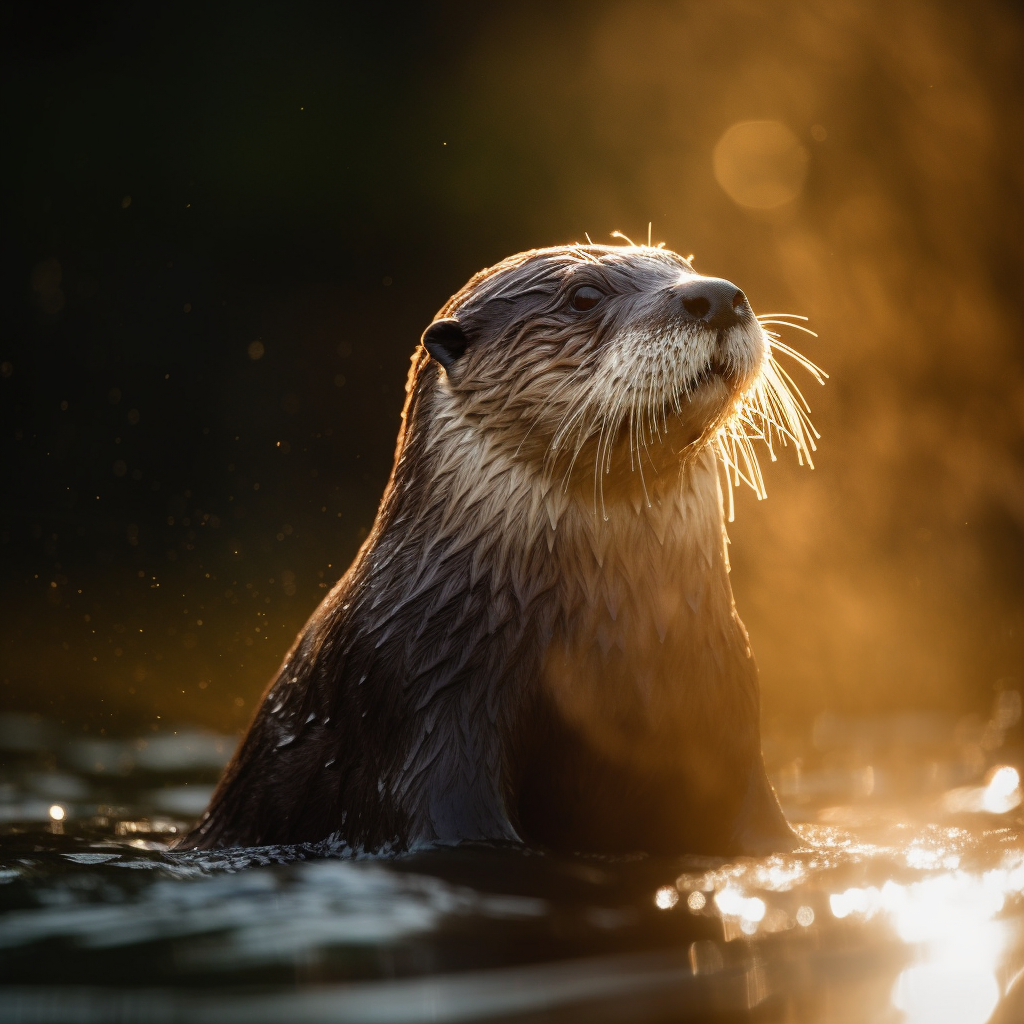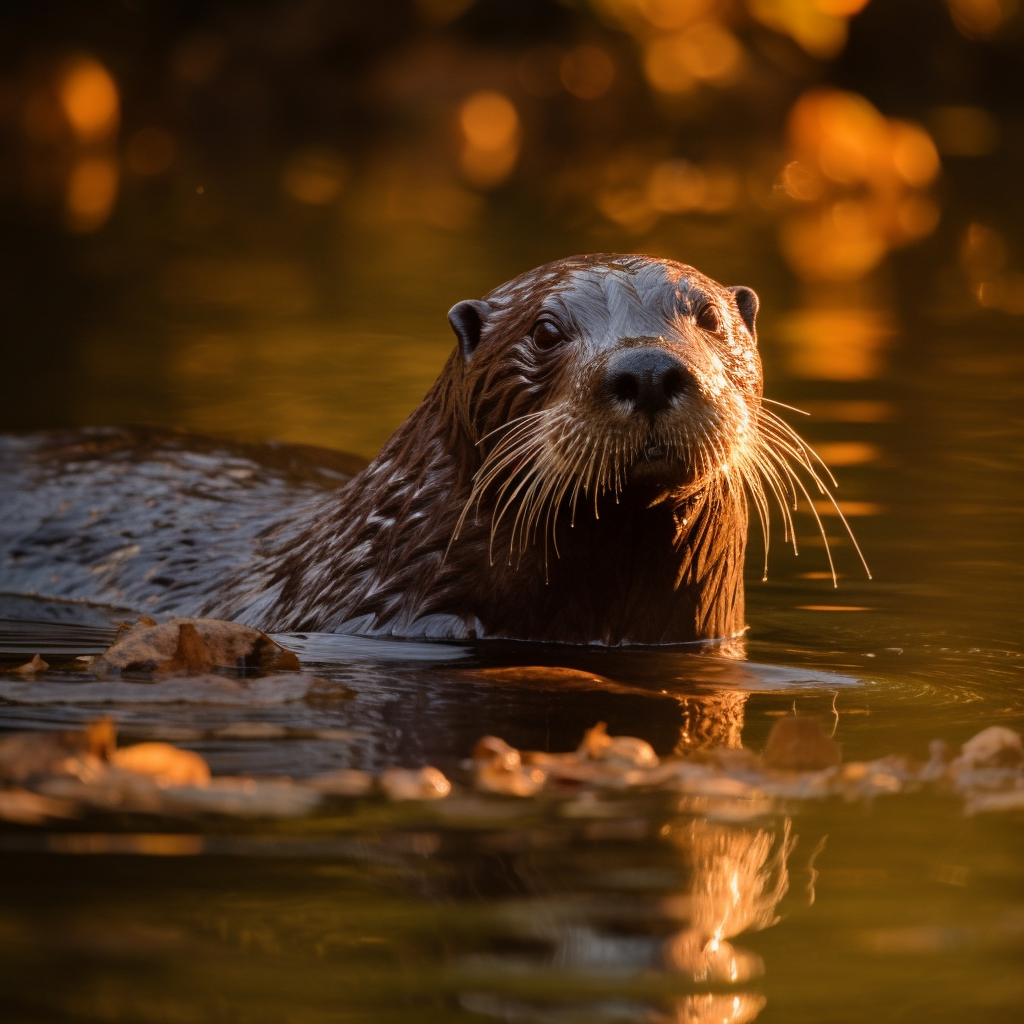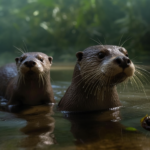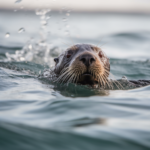The River Otter Kentucky is a fascinating and charismatic mammal that can be found in the waterways of Kentucky, United States. These playful creatures are known for their sleek bodies, webbed feet, and long, muscular tails, which make them excellent swimmers. River otters are highly adaptable and can thrive in a variety of aquatic habitats, including rivers, lakes, and marshes. They are skilled hunters, feeding on fish, amphibians, crustaceans, and even small mammals. Unfortunately, due to habitat loss and pollution, the population of river otters in Kentucky has declined in the past. However, conservation efforts and strict regulations have helped to restore their numbers, making it possible to spot these delightful creatures in the wild once again. In this article, we will explore the life of the river otter in Kentucky, their habitat, behavior, and the conservation efforts being made to protect these remarkable animals. So, let’s dive in and discover the wonders of the River Otter Kentucky!
Key Takeaways
- River otters are native to Kentucky and can be found in various water bodies such as rivers, lakes, and wetlands.
- They are excellent swimmers and have adapted to their aquatic habitat with webbed feet, a streamlined body, and a thick fur coat.
- River otters play a crucial role in maintaining the health of aquatic ecosystems by controlling populations of fish and invertebrates.
- Conservation efforts have helped in the recovery of river otter populations in Kentucky, but habitat loss and pollution remain threats to their survival.
- Observing river otters in their natural habitat can be a rewarding and educational experience, but it is important to maintain a respectful distance to avoid disturbing them.
The Kentucky River: A Natural Habitat for Otters
A. Overview of the Kentucky River
The Kentucky River is a prominent waterway that flows through the state of Kentucky, offering a diverse and thriving ecosystem for various wildlife species. Spanning approximately 260 miles, the river is a vital source of water and sustenance for numerous animals, including the fascinating river otter.
The Kentucky River, with its meandering path and lush surroundings, provides an ideal habitat for otters. These playful creatures are well-adapted to the river’s ecosystem, making it their home and thriving in its waters. The river’s clean and unpolluted environment, coupled with an abundance of food sources, makes it an attractive dwelling for the North American River Otter.
B. The Ecosystem of the Kentucky River
The ecosystem of the Kentucky River is a complex web of interconnected organisms, each playing a vital role in maintaining the delicate balance of nature. From the riverbanks to the depths of the water, a diverse array of flora and fauna coexist harmoniously.
-
Flora: The riverbanks of the Kentucky River are adorned with a variety of plant life, including willows, sycamores, and cottonwoods. These trees provide essential shade and shelter for otters, creating a suitable environment for their survival.
-
Fauna: The Kentucky River is home to a rich diversity of wildlife, making it a prime location for nature enthusiasts and researchers alike. Apart from river otters, visitors may spot other species such as beavers, muskrats, and various fish species like bass and catfish. The presence of these animals indicates a healthy and thriving ecosystem.
-
Water Quality: The Kentucky River boasts clean and clear waters, thanks to ongoing conservation efforts and environmental protection measures. The high water quality is crucial for the survival of otters, as they rely on clean water for hunting and maintaining their overall well-being.
-
Food Sources: Otters are opportunistic hunters, feeding on a diet primarily consisting of fish, crustaceans, amphibians, and small mammals. The Kentucky River provides an abundant supply of these food sources, ensuring that otters have access to a varied and nutritious diet.
-
Conservation Efforts: Recognizing the importance of preserving the river’s ecosystem and the species that call it home, various organizations and government agencies have implemented conservation initiatives. These efforts aim to protect the river otter population and maintain the overall health of the Kentucky River ecosystem.
In conclusion, the Kentucky River serves as a natural haven for river otters, offering them a thriving habitat and abundant food sources. The diverse ecosystem of the river, coupled with ongoing conservation efforts, ensures the preservation of these fascinating creatures for future generations to enjoy. Whether you’re an avid wildlife enthusiast or simply appreciate the beauty of nature, a visit to the Kentucky River provides a unique opportunity to witness the playful antics of otters in their natural environment.
The River Otter: An Intriguing Inhabitant of Kentucky

A. Understanding the River Otter
The river otter is a fascinating creature that calls the waterways of Kentucky home. These playful and intelligent mammals are part of the weasel family and are known for their sleek bodies, webbed feet, and long, muscular tails. River otters are highly adapted to their aquatic lifestyle, making them excellent swimmers and divers.
River otters are native to North America and can be found in various habitats, including rivers, lakes, and marshes. In Kentucky, they are commonly spotted in the state’s rivers and waterways, such as the Ohio River and the Cumberland River. These water bodies provide the otters with an abundant food source and a suitable environment to thrive.
B. What Do River Otters Eat?
River otters are carnivorous creatures with a diverse diet. They are opportunistic hunters and feed on a variety of aquatic animals. Their diet primarily consists of fish, such as catfish, bass, and trout. However, they are not limited to just fish. River otters also consume crayfish, frogs, turtles, and even small mammals like muskrats and mice.
These agile hunters use their sharp teeth and strong jaws to catch and devour their prey. River otters are skilled at hunting underwater, using their excellent swimming abilities to chase down fish and other aquatic creatures. They can hold their breath for several minutes, allowing them to search for food underwater without resurfacing.
C. The Life Cycle of a River Otter in Kentucky
The life cycle of a river otter in Kentucky is a fascinating journey that begins with birth and ends with the next generation. Female otters typically give birth to a litter of two to four pups in a den located near the water’s edge. These dens can be found in riverbanks, hollow logs, or abandoned beaver lodges.
The newborn otters are blind and helpless at birth, relying entirely on their mother for nourishment and protection. As they grow, the mother otter teaches her pups essential survival skills, such as swimming, diving, and hunting. The young otters stay with their mother for about a year before venturing out on their own.
Once mature, river otters establish their own territories along Kentucky’s waterways. They mark their territories with scent markings and communicate with other otters through vocalizations and body language. River otters are social animals and may form small family groups or live in pairs.
In Kentucky, efforts are being made to protect and preserve the river otter population. Conservation organizations and wildlife agencies work together to monitor otter populations, study their behavior, and ensure their habitats remain intact. These efforts contribute to the overall preservation of Kentucky’s diverse fauna and the delicate balance of river ecosystems.
So, the next time you find yourself near a Kentucky river or waterway, keep an eye out for these playful and charismatic creatures. River otters are a true testament to the beauty and resilience of Kentucky’s natural environment.
Where to Find Otters in Kentucky
Kentucky is home to a diverse range of wildlife, including the elusive and playful river otter. These fascinating creatures can be found in various locations across the state, particularly near rivers and waterways. If you’re interested in spotting river otters in Kentucky, here are some popular spots and the best times to increase your chances of a sighting.
A. Popular Otter Spots in Kentucky
Kentucky boasts several areas where river otters are known to thrive. These locations provide suitable habitats for these semi-aquatic mammals, offering ample food sources and shelter. Here are some popular otter spots in Kentucky:
-
Green River: The Green River, which stretches across central Kentucky, is a prime location for otter sightings. This river is known for its clean and clear waters, making it an ideal habitat for these playful creatures. Keep an eye out for otters near the riverbanks or floating logs, as they are often seen basking in the sun or playing in the water.
-
Ohio River: The Ohio River, which forms the northern border of Kentucky, is another great spot to observe river otters. This expansive river provides an abundance of fish and other aquatic prey, attracting otters to its shores. Look for otters swimming near the river’s edge or diving for food in the deeper sections.
-
Cumberland River: The Cumberland River, located in southeastern Kentucky, is a popular destination for otter enthusiasts. This river offers a diverse ecosystem, with plenty of fish and vegetation to support otter populations. Look for otters near the riverbanks, particularly in areas with dense vegetation or fallen trees.
-
Kentucky Lake: Kentucky Lake, one of the largest man-made lakes in the United States, is another promising location for otter sightings. This vast body of water provides an array of habitats, including marshes, coves, and shallow areas, which are all attractive to otters. Keep an eye out for otters swimming near the shoreline or playing in the shallows.
B. Best Times to Spot River Otters in Kentucky
While river otters can be spotted throughout the year, there are certain times when your chances of seeing them are higher. Here are the best times to spot river otters in Kentucky:
-
Early Morning and Late Evening: River otters are most active during the early morning and late evening hours. During these times, they are more likely to be out and about, foraging for food or engaging in playful behavior. Plan your otter-spotting excursions during these times for the best chance of a sighting.
-
Spring and Summer: Spring and summer are particularly good seasons for otter sightings in Kentucky. During these warmer months, otters are more active and visible as they take advantage of the abundant food sources and favorable weather conditions. Visit otter habitats during these seasons for optimal viewing opportunities.
-
Quiet and Calm Days: Otters are generally shy and sensitive to disturbances. Choose days when the weather is calm and the water is still, as this creates a peaceful environment that is more likely to attract otters. Avoid visiting otter habitats during periods of heavy rain or strong winds, as otters may be less active during these conditions.
Remember, when observing river otters in their natural habitat, it is important to maintain a respectful distance and avoid disturbing their behavior. Binoculars or a camera with a zoom lens can help you get a closer look without causing any harm. Enjoy the beauty of these fascinating creatures and the natural wonders of Kentucky’s rivers and waterways.
The Kentucky River Otter Season
A. Understanding the River Otter Season in Kentucky
The state of Kentucky is home to a diverse range of wildlife, including the fascinating river otter. These playful and charismatic creatures can be found in various waterways across the state, making Kentucky a prime location for otter enthusiasts and nature lovers alike.
The river otter season in Kentucky refers to the time of year when otters are most active and visible in the wild. While otters can be spotted throughout the year, there are certain periods when their behavior and sightings are more prevalent.
In Kentucky, the river otter season typically spans from late winter to early spring. During this time, otters are more active as they search for mates and establish territories. The cold temperatures during winter do not deter these resilient creatures, as they are well adapted to thrive in aquatic environments.
B. How the Season Affects Otter Behavior and Sightings
The river otter season in Kentucky has a significant impact on otter behavior and sightings. As the weather begins to warm up, otters become more active and visible in their natural habitats. Here are a few ways the season affects otter behavior:
-
Mating and Reproduction: During the river otter season, otters engage in mating rituals. Male otters will compete for the attention of females, often engaging in playful and energetic displays. This behavior increases the chances of spotting otters in the wild.
-
Territory Establishment: Otters are territorial creatures, and during the season, they mark their territories with scent markings and vocalizations. This territorial behavior can lead to increased otter sightings, as they become more active in defending their territories.
-
Food Availability: The river otter season coincides with the spawning season of many fish species. This abundance of food sources attracts otters to rivers and streams, increasing the likelihood of spotting them as they hunt for fish.
To increase your chances of spotting river otters during the season, it’s essential to visit areas with suitable otter habitats. Kentucky’s rivers and waterways, such as the Ohio River and the Cumberland River, are known to support healthy otter populations. Additionally, nature parks and wildlife reserves in the state offer opportunities for otter sightings.
While observing river otters in their natural habitat can be an exciting experience, it’s crucial to remember that these animals are protected under state and federal laws. It’s important to maintain a respectful distance and avoid disturbing their natural behaviors. By appreciating these incredible creatures from a distance, we can contribute to the conservation efforts aimed at preserving the river otter population in Kentucky’s beautiful river ecosystems.
The Peculiar Case of Kentucky Owning the Ohio River
A. Historical Background of Kentucky’s Ownership of the Ohio River
The ownership of the Ohio River by the state of Kentucky is a fascinating historical quirk that has shaped the region‘s identity and influenced its wildlife. To understand this peculiar situation, we must delve into the history of Kentucky and its relationship with the Ohio River.
Kentucky, known as the “Bluegrass State,” was originally part of Virginia until it gained statehood in 1792. At the time, the Ohio River served as a vital transportation route, connecting the eastern states to the western frontier. As settlers moved westward, the river became a lifeline for trade and commerce.
In the early 19th century, a dispute arose between Kentucky and neighboring states over the ownership of the Ohio River. The crux of the matter was the interpretation of the state’s original boundaries. Kentucky argued that its borders extended to the low-water mark on the northern shore of the river, while other states claimed that the boundary stopped at the river’s edge.
The issue was eventually brought before the Supreme Court in 1820, in a case known as “Kentucky v. Indiana.” The court ruled in favor of Kentucky, affirming its ownership of the Ohio River up to the low-water mark on the northern bank. This landmark decision solidified Kentucky’s claim to a significant portion of the river.
B. Impact on the River Otter Population
The ownership of the Ohio River by Kentucky has had a profound impact on the river otter population in the region. River otters, scientifically known as Lontra canadensis, are semi-aquatic mammals that thrive in freshwater ecosystems. They are known for their playful nature, sleek fur, and remarkable swimming abilities.
Kentucky’s ownership of the Ohio River has provided a unique opportunity for the conservation and preservation of river otters. The state has implemented various initiatives to protect the otter population and their habitat. Kentucky wildlife agencies have worked tirelessly to restore and maintain healthy river ecosystems, ensuring an ideal environment for otters to thrive.
River otters in Kentucky benefit from the state’s extensive network of rivers and waterways, including the Ohio River. These water bodies provide an abundance of food sources, such as fish, crayfish, and amphibians, which form the core of the otter‘s diet. The diverse river systems in Kentucky offer a rich and varied habitat for otters to explore and establish their territories.
In recent years, river otter sightings have become increasingly common in Kentucky. Nature enthusiasts and wildlife lovers flock to the state’s rivers and nature parks in the hopes of catching a glimpse of these charismatic creatures. River otters have become an iconic symbol of Kentucky’s commitment to environmental protection and the preservation of its unique fauna.
In conclusion, Kentucky’s ownership of the Ohio River has not only shaped the state’s history but also had a significant impact on its wildlife. The conservation efforts and favorable habitat provided by the river have allowed the river otter population to flourish in Kentucky. As we continue to appreciate and protect these remarkable creatures, we must also recognize the importance of maintaining the delicate balance of our river ecosystems.
The Soundless Kentucky Oornetje: A Unique Aspect of Kentucky Otters

A. What is a Kentucky Oornetje?
When it comes to the fascinating world of Kentucky otters, there is one aspect that sets them apart from their counterparts in other regions – the soundless Kentucky Oornetje. But what exactly is a Kentucky Oornetje?
The term “Oornetje” refers to a unique adaptation found in the otters inhabiting the rivers of Kentucky. It is a specialized structure located in their ears that allows them to navigate their watery habitats with ease. The Oornetje acts as a natural amplifier, enhancing their ability to detect even the faintest sounds underwater. This remarkable adaptation enables Kentucky otters to locate prey, communicate with one another, and navigate their environment effectively.
B. The Significance of the Soundless Kentucky Oornetje
The soundless Kentucky Oornetje plays a crucial role in the survival and success of otters in the Kentucky river systems. Here are a few key reasons why this adaptation is significant:
-
Enhanced Prey Detection: Otters rely on their acute hearing to locate fish, crustaceans, and other aquatic creatures that make up their diet. The Oornetje allows them to detect the subtle movements and sounds made by their prey, giving them a distinct advantage when hunting.
-
Efficient Communication: Communication is vital for otters, especially when it comes to social interactions and mating rituals. The soundless Oornetje enables otters to communicate effectively underwater, allowing them to convey messages and establish social bonds without the need for vocalizations.
-
Improved Navigation: Kentucky rivers can be complex and challenging to navigate, with various obstacles and currents. The Oornetje helps otters accurately perceive their surroundings, including underwater structures, potential threats, and suitable resting spots. This adaptation aids in their navigation and ensures their safety in their riverine habitats.
-
Survival in River Ecosystems: River ecosystems are dynamic and ever-changing, requiring animals to adapt to survive. The soundless Oornetje is a remarkable adaptation that allows Kentucky otters to thrive in their specific habitat. It gives them a competitive edge in finding food, avoiding predators, and successfully reproducing.
In conclusion, the soundless Kentucky Oornetje is a unique aspect of Kentucky otters that sets them apart from other otter populations. This specialized ear structure enhances their ability to detect sounds underwater, contributing to their survival and success in the rivers of Kentucky. The Oornetje enables otters to efficiently locate prey, communicate with one another, and navigate their environment, making it a crucial adaptation for their riverine lifestyle.
Otter Ownership: A Comparative Look at Kentucky and Georgia
A. Can You Own a River Otter in Kentucky?
When it comes to owning a river otter in Kentucky, the laws are quite clear. The Kentucky Department of Fish and Wildlife Resources strictly prohibits the possession of river otters as pets. This regulation is in place to protect the otters and ensure their conservation in the wild.
River otters are fascinating creatures that play a vital role in the ecosystem. They are native to Kentucky and are well-adapted to the state’s rivers and waterways. However, their populations have faced challenges in the past due to habitat loss and overhunting. To preserve and maintain healthy otter populations, it is crucial to keep them in their natural habitats.
While it may be tempting to have a river otter as a pet, it is important to remember that they are wild animals with specific needs and behaviors. They require a large, naturalistic habitat with access to water for swimming and hunting. Keeping them in captivity can be stressful for the otter and may lead to health issues.
B. Comparing Otter Ownership Laws in Kentucky and Georgia
When comparing otter ownership laws between Kentucky and Georgia, there are some notable differences. While Kentucky strictly prohibits owning river otters as pets, Georgia has different regulations in place.
In Georgia, it is legal to own a river otter as a pet, but there are specific requirements that must be met. The Georgia Department of Natural Resources has established guidelines for otter ownership, including obtaining a permit and meeting certain criteria related to the otter‘s care and welfare.
These regulations in Georgia aim to ensure that otters are kept in suitable conditions and that their welfare is protected. It is important for potential otter owners to understand the responsibilities and commitments involved in caring for these animals before considering ownership.
It is worth noting that owning a river otter, even in states where it is legal, is not for everyone. Otters are highly active and social animals that require a significant amount of time, space, and resources to thrive. They have specific dietary and environmental needs that must be met to ensure their well-being.
In conclusion, while owning a river otter as a pet may be allowed in some states like Georgia, it is important to consider the welfare of these animals and the regulations in place. In Kentucky, the focus is on preserving otters in their natural habitats and protecting their populations.
The Current Status of River Otters in Kentucky

A. Are There Otters in Kentucky Today?
River otters, also known as North American River Otters, are native to Kentucky and can be found in various waterways throughout the state. These playful and charismatic creatures have made a remarkable comeback in recent years after facing significant population declines due to habitat loss and unregulated hunting.
Thanks to successful conservation efforts, river otters have been reintroduced to many areas where they were once absent. Today, otters can be spotted in rivers, lakes, and wetlands across Kentucky, bringing joy to nature enthusiasts and wildlife lovers.
B. Conservation Efforts for the River Otter in Kentucky
The resurgence of river otters in Kentucky is a testament to the dedicated conservation efforts undertaken by various organizations and government agencies. Recognizing the importance of these fascinating creatures to the state’s biodiversity, steps have been taken to protect and preserve their habitat.
One of the key initiatives in otter conservation is the restoration and creation of suitable habitats. Kentucky’s rivers and wetlands have been restored and managed to provide optimal conditions for otters to thrive. This includes ensuring clean water, abundant food sources, and suitable shelter.
Additionally, regulations have been put in place to protect river otters from hunting and trapping. Strict laws and regulations have been implemented to control the harvest of otters, allowing their populations to recover and flourish. These measures have been crucial in ensuring the long-term survival of this species in Kentucky.
To monitor the population and behavior of river otters, researchers and wildlife biologists conduct regular surveys and studies. These efforts help gather valuable data on otter populations, distribution, and habitat use. By understanding their needs and behaviors, conservationists can make informed decisions to further protect and manage otter populations effectively.
Furthermore, education and outreach programs play a vital role in otter conservation. By raising awareness about the importance of these creatures and their ecological role, people are encouraged to appreciate and protect them. Public engagement initiatives, such as nature walks, workshops, and educational campaigns, help foster a sense of stewardship towards Kentucky’s fauna and natural resources.
In conclusion, the current status of river otters in Kentucky is a success story of conservation and preservation. Through dedicated efforts, these charming creatures have made a remarkable comeback, enriching the state’s rivers and wetlands with their playful presence. By continuing to protect their habitats, regulate hunting, and educate the public, Kentucky ensures a bright future for its river otter population.
Conclusion
In conclusion, the river otter population in Kentucky has made a remarkable recovery over the past few decades. Thanks to conservation efforts and the implementation of strict regulations, these playful and intelligent creatures have been able to thrive in their natural habitat once again. The reintroduction of river otters to Kentucky’s waterways has not only brought joy to wildlife enthusiasts but has also had a positive impact on the overall ecosystem. These otters play a crucial role in maintaining a healthy balance in aquatic ecosystems by controlling populations of prey species and helping to improve water quality. As we continue to protect and preserve their habitats, we can ensure that future generations will have the opportunity to witness the beauty and resilience of these fascinating creatures. So, let’s celebrate the success of the river otter population in Kentucky and continue to support conservation efforts to ensure their long-term survival.
Frequently Asked Questions
1. Are there otters in Kentucky?
Yes, there are otters in Kentucky. Specifically, the North American River Otter is found in the Kentucky River and other waterways throughout the state. Their presence is a testament to the health of Kentucky’s rivers and the success of otter conservation efforts.
2. Where can I find otters in Kentucky?
Otters can be found in several waterways across Kentucky, including the Kentucky River. They are often spotted in Kentucky nature parks and other areas with healthy river ecosystems. Otter spotting in Kentucky can be a delightful experience for nature enthusiasts.
3. What do river otters eat?
River otters are carnivorous and their diet primarily consists of fish. However, they also eat various amphibians, crustaceans, and occasionally small mammals and birds. Their diet reflects the biodiversity of Kentucky’s river ecosystems.
4. Can you own a river otter in Georgia?
No, it is generally illegal to own a river otter as a pet in Georgia, as well as in many other states. This is due to the importance of otters in maintaining healthy river ecosystems and the challenges of providing appropriate care for them in a domestic setting.
5. What is the Kentucky River otter season?
The Kentucky River otter trapping season typically runs from late fall to early winter. However, specific dates can vary from year to year. It’s important to check with the Kentucky Department of Fish and Wildlife Resources for current regulations.
6. Why does Kentucky own the Ohio River?
The Ohio River, while forming the northern border of Kentucky, is considered to be owned by Kentucky based on historical treaties and legal decisions. This ownership extends to the low-water mark on the river’s northern (Indiana and Illinois) or northwestern (Ohio) side.
7. What is a Kentucky oornetje?
The term “Kentucky oornetje” appears to be a misunderstanding or mistranslation. There is no known animal or species by this name in Kentucky’s fauna or elsewhere.
8. What are some characteristics of the river otter?
The North American River Otter, common in Kentucky, is known for its playful behavior, agility in the water, and adaptability. They have streamlined bodies, fully webbed feet, and a strong, flat tail that aids in swimming. They are also known for their dense, waterproof fur.
9. How are river otters being conserved in Kentucky?
Otter conservation in Kentucky involves habitat preservation, monitoring of otter populations, and regulations on trapping. The Kentucky Department of Fish and Wildlife Resources plays a key role in these conservation efforts.
10. Are there any specific places for otter spotting in Kentucky?
While otters can be found in many of Kentucky’s rivers and waterways, some nature parks and reserves offer better chances for otter spotting. These include the Mammoth Cave National Park and the Land Between the Lakes National Recreation Area. Always remember to observe wildlife respectfully and from a distance.




